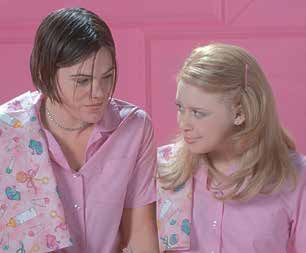
By Gary Kramer–
Out lesbian filmmaker Jamie Babbit’s first feature, But I’m a Cheerleader, is being reissued in a Digital 4K Ultra HD Director’s Cut on December 8. The campy, colorful film, is about Megan (Natasha Lyonne), a teenager, being sent to True Directions, a gay conversion therapy program to “cure” her of her homosexuality. The comedy was ahead of its time when it received its original theatrical release in the summer of 2000. It has since been embraced as a queer cinema classic.
Babbit also has a new film, The Stand In, getting a virtual release December 11. The comedy features Drew Barrymore playing both Candy Black, an actress known for making pratfall comedies, and her stand in, Paula, who agrees to go to rehab for Candy in exchange for rebooting her career. Of course, the situation gets complicated when Paula manipulates things—including Candy’s boyfriend—to her advantage.
The filmmaker chatted me for the San Francisco Bay Times about both her “new” movies in a recent phone interview.

Gary M. Kramer: Looking back on this film after 20 years, what can you say about making Cheerleader?
Jamie Babbit: It’s all about the long game! The fun thing about the director’s cut release was that I got to look back on some of the scenes I deleted 20 years ago. The ‘90s were a different time in the queer movement—the legacy of AIDS and the horrors of this plague in the gay community meant a lot of people weren’t willing to laugh. But Cheerleader makes fun of straight and gender non-conformity, but also the queer community. And I don’t want to be part of a community I can’t make fun of. I was poking fun from the inside. If you want to make fun of a community, you better be part of it.
Gary M. Kramer: It has a very distinctive tone—not just the broad humor and campiness or the bright color palette. It’s the gay power vibe that will win against all oppression.
Jamie Babbit: I was interested in gender politics at the time, which people weren’t really talking about. As a femme lesbian, I felt I wasn’t allowed to be a lesbian because I’m not butch. There was an invisibility of femme lesbians. I was interested in the construct of gender and how ridiculous it is; this idea of men doing less girly/women doing less boyish things makes you less gay. A toy store shows how gender is and what boys and girls should be. We bought the Barbie Dream House, and I said this is what the movies should look like.
Gary M. Kramer: Your film was a comic response to the rebellious New Queer Cinema films of the time. What observations do you have about that?
Jamie Babbit: I was younger, and a woman, so I had a different view. I was a newer generation coming up after the queer new wave. Every 5 years makes a difference, and I was on the cusp of all of that stuff. I have always had a wry sense of humor. I was involved in the Riot Grrl movement, and they were great at empowering girls like me to make queer art however you want, and not copy others. I was pure to myself and own instincts. Gregg Araki saw my film and said it was the gayest movie he’d ever seen. I wasn’t sure if it was a compliment or a dis. He was taken aback by how out and gay it was.
Gary M. Kramer: Like Cheerleader, The Stand In is also about finding your true identity. Can you talk about this theme of identity and reinvention, which is integral to all of your films?
Jamie Babbit: I definitely think part of my artistic influences and reason for being a filmmaker is my love for diving into a different world emotionally. I live more in my head than in reality, so I try on new identities to help actors and make shot decisions from the point of view of the characters. One way I’m able to tell each story is that I climb inside each character. In Cheerleader, the characters are told to be one way, but they reinvent themselves as who they are, not as society tells them to be. I relate to both of Drew’s characters in The Stand In who have valid, interesting ways of looking at the world.
Gary M. Kramer: On that same topic, can you address the idea of passing in The Stand In? All the major characters are living some kind of double life, which is a good metaphor for closeted people.
Jamie Babbit: Maybe only a queer person would be interested in telling this story of characters living in different realities. I do think that everyone lives a double life and creates who they want to be.
Gary M. Kramer: Of course, I have to ask: if you had a double who could allow you to do what you wanted, what would you do instead?
Jamie Babbit: I have dreams of living a quiet life in a cabin and having creative pursuits, like handcrafting, knitting, making furniture. That film The Social Dilemma highlights the destructive nature of technology that siphons us into tunnels so that we stop talking to each other and understanding how people think. We have to express our creativity and talk to people.
© 2020 Gary M. Kramer
Gary M. Kramer is the author of “Independent Queer Cinema: Reviews and Interviews,” and the co-editor of “Directory of World Cinema: Argentina.” Follow him on Twitter @garymkramer
Published on December 3, 2020
Recent Comments